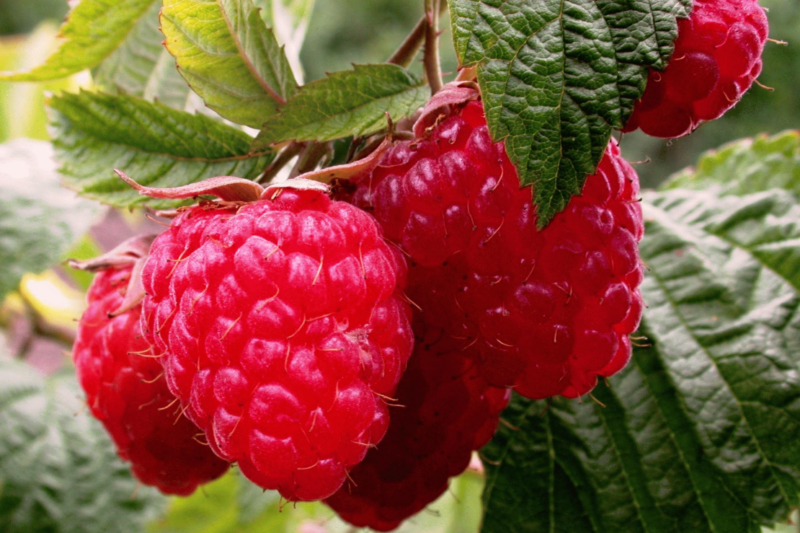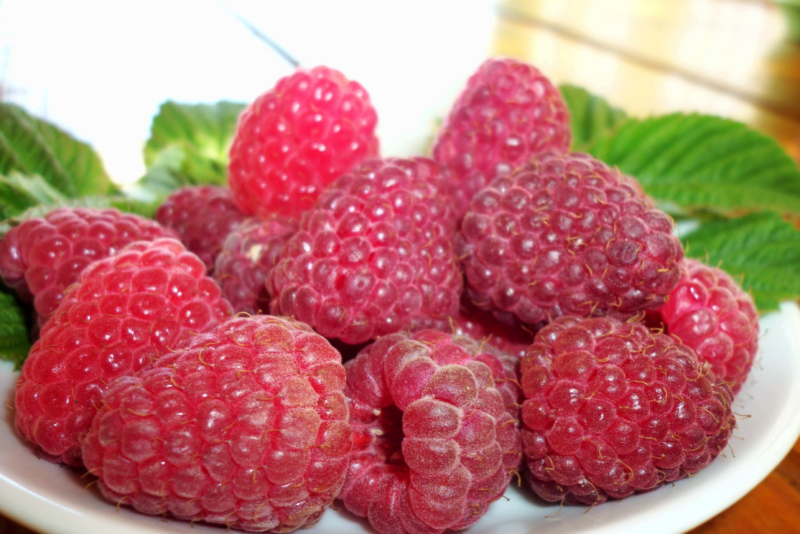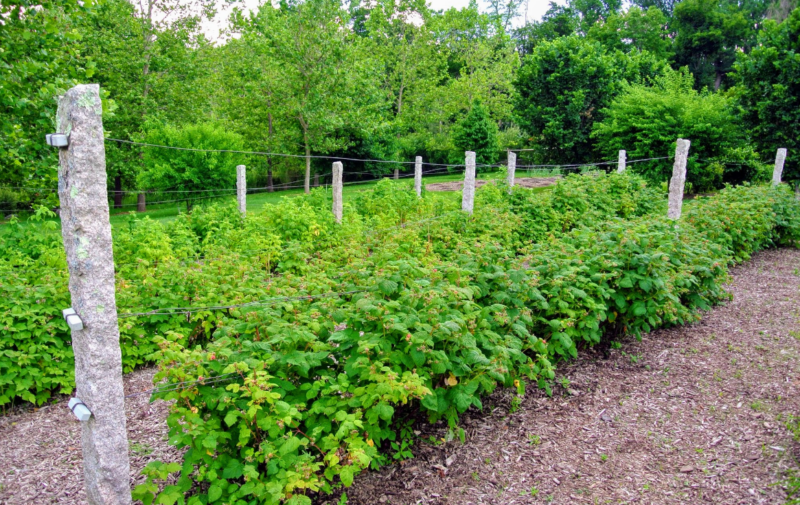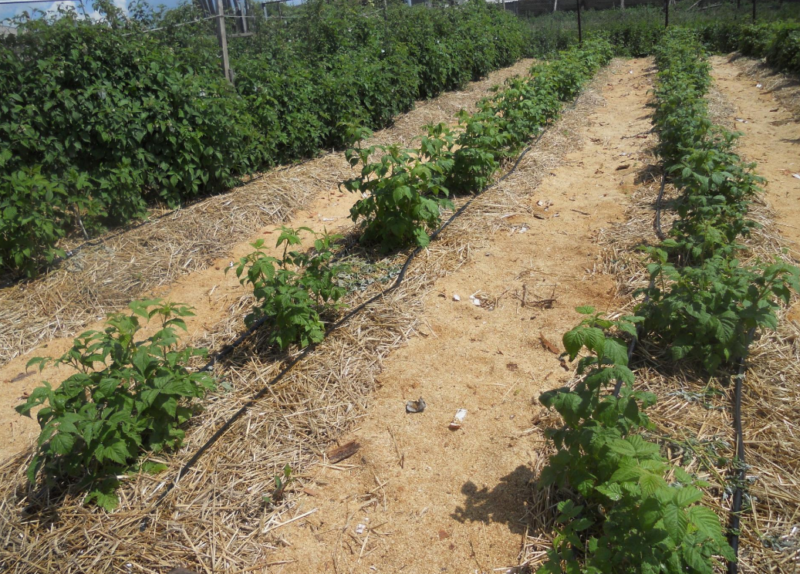One of the most popular berry plants is especially appreciated for its pleasant refreshing taste, the healing effect of fruits. Raspberry ordinary does not require complex care, responds well to dressing, pruning, moderate watering. Berries are used in fresh, frozen and dried form, are used for canning.
Material Content:
Botanical Description
Many summer residents and owners of their own gardens already grow or dream to plant raspberry (Rubus idaeus) on their plot. Perennial grows in the form of a shrub, has a branched rhizome, straight stems 1–2 m high, 8–15 mm thick at the base. Plant development occurs within 2 years.
In the first year, green shoots covered with silver coating grow. Young stems are lignified in autumn, in red-fruited varieties they acquire red-brown, in yellow raspberries - light yellow.
The shoots of the second type give a crop, after fruiting they dry up.
The botanical description necessarily mentions that the leaves of the plant are petiolate, complex, pinnate, with 3-5 leaves. The plates on top are green, slightly “corrugated”, the bottom is grayish-whitish due to plaque and a large number of small hairs. There are many short sharp spikes on the shoots. New varieties without spikes have been created.
Cystic inflorescences grow from the axils of the leaves. It is difficult to determine from the nondescript white or greenish flowers that the species belongs to the Pink family, which includes apple, cherry, almond.
In summer and / or autumn, fruits ripen, they are complex, as they consist of many fragrant small drupes.In everyday life, the name "berries" is more often used. Raspberry bushes with good care grow in the same place, give a full crop up to ten years or more.
The best varieties of raspberries
There are groups of summer, autumn and repair varieties. They differ in terms of ripening, thickness of the bushes, productivity, color, size, taste and size of berries. Raspberry fruits are harvested on biennial shoots in June – July. The berries are medium or large, sweet, fragrant. Traditional varieties of this group need a lot of sunlight, form a lot of root shoots.
Remontant raspberry bears fruit twice - in June and August, gives large berries, well transportable.
It is easy to grow an autumn ripening crop. It gives a crop in August-September on the shoots of the current year; less susceptible to disease. The best varieties of raspberries are in each group.
Short description:
- "Reward" is an early species with round-conical berries.
- Elida is one of the best early varieties with large fruits.
- "Balm" - summer raspberries of medium ripening with large berries.
- "Hussar" - the plant is resistant to disease, with fragrant bright red fruits of a conical shape.
- "Giant" - a large-fruited variety, productive, undemanding to care.
- "Malakhovka" - raspberries of summer ripening with elongated berries.
- "Bell" is a summer high-yielding variety for universal use.
- "Abundant" - a dessert view with large slightly elongated fruits; winter-hardy, resistant to diseases.
- “Bryansk Divo” is a remont raspberry with a traditional aroma and taste.
- “Heat Bird” is a plant with large berries.
- “Ruby necklace” is the same category of variety suitable for commercial cultivation.
- "Caramel" - remont raspberries with large sweet berries.
- "Galaxy" - a type of universal purpose, standard bushes.
- "Apricot" - a repairing variety with yellow berries; resistant to low temperatures.
- "Golden Giant" - raspberries with golden large fruits of a gentle and pleasant taste.
Residents of the northern regions of Russia can grow few of the raspberries. A plant without cover dies at –30 ° C. Varieties with increased winter hardiness: “Kuzmina News”, “Usanka”, “Marlboro”.
Growing Features
Raspberries grow on any sufficiently fertile, well-drained substrate. With stagnation of water, poor soil aeration, diseases spread more quickly. Raspberry in natural conditions prefers edges and glades, grows under a forest canopy.
At the cottage, it is recommended to choose the most well-lit place. Bushes tolerate only slight shading. You can plant raspberries next to a low fence, a fence that will protect against drafts, hold snow.
Outdoor landing
The ideal time for planting raspberries is autumn. Then the rhizome has a sufficient period for growth. And also culture can be planted in the spring, and rooted green cuttings - in the summer. Choose a site with neutral or slightly acidic soil. A place is prepared 2–4 weeks before the start of work: they dig, make holes or a trench.
Unwanted predecessors for raspberries - strawberries, currants, potatoes.
Raspberries are planted in separate bushes or in a row. In the second case, you can tie it to trellises. The rhizome is actively growing, so the bushes should not be placed too close to each other. In a row, the distance between individual plants is 50–100 cm. At least 120–200 cm between each row is kept so that there is a lot of light and air.
When planting, they dig a recess of 40 * 50 cm. Prepared soil is poured onto the bottom with a knoll. The roots are moistened in a mullein solution, lowered into the landing pit. Sprinkle with earth, gently pressed to the rhizome and rammed. Watered, mulched with humus.
How to care for bushes
Raspberries prefer moist but not swampy soil. In spring and summer, water more abundantly and more often.Each adult bush requires up to 10 liters of water. The first irrigation is before flowering, the next irrigation is carried out before and during the ripening of the berries, after harvesting, before frost. Humidification combined with top dressing.
Fertilizers are applied to the soil during planting, as well as before flowering and in autumn. Starting in June, the plant is preparing for winter, it does not require top dressing. Organic raspberries are preferred for raspberries. Of the mineral elements, bushes especially need potassium and magnesium. Deficiency of these substances successfully replenishes wood ash.
The soil between the bushes should not be dug up often.
Rhizomes form a layer favorable for growth, which is undesirable to destroy. Between the bushes and in the aisles leaves are left in the fall, in spring and summer a layer of mulch (straw, peat, dry grass without seeds) is poured.
The shoots on which the crop is formed are tied to pegs or to a wire stretched between the posts. For varieties of European selection, which in the conditions of Russia may be threatened with freezing, they practice bending stems for the winter. Bushes bend to each other and bind stems.
The nuances of trimming
Basic techniques: shortening of fruiting shoots, removal of root shoots, thickening bushes, making it difficult to water and harvest. The first time pruning is carried out in the spring after planting. Cut fruit-bearing shoots to 20 cm.
Starting from the second year, the branches are annually shortened in spring or autumn at the end of the harvest. After wintering, the tops are cut to a strong bud on the stem, which should be thicker than a pencil. The necessary activities that take place in the fall are to remove the shoots of the second year of life. Cut old stems as close to the rhizome as possible.
Breeding methods
Common raspberries are propagated by dividing the bush, cuttings and layering. The last two techniques are used to obtain a large amount of planting material. For propagation by cuttings, varieties are suitable that easily form subordinate roots on the shoots. Twigs cut from young, healthy and slightly lignified stems. Leaves are removed, except for 2-3 top. Place material in moist, fertile soil. Rooting in mini-greenhouses occurs within 2-3 weeks.
Common Diseases and Pests
Sick raspberries are, first of all, a decrease in the quality and quantity of berries. Fungal diseases are the most dangerous for the plant. Root rot is manifested by drying of the tops of shoots, stunting. Processed with a Bordeaux mixture (3%). The main pest - a raspberry beetle - is shaken off to the ground and manually destroyed.
Risk factors should be avoided - too thick plantings, waterlogging of the soil, the introduction of excessive amounts of fertilizer. For prevention, they are sprayed with a decoction of nettles and horsetail.


















